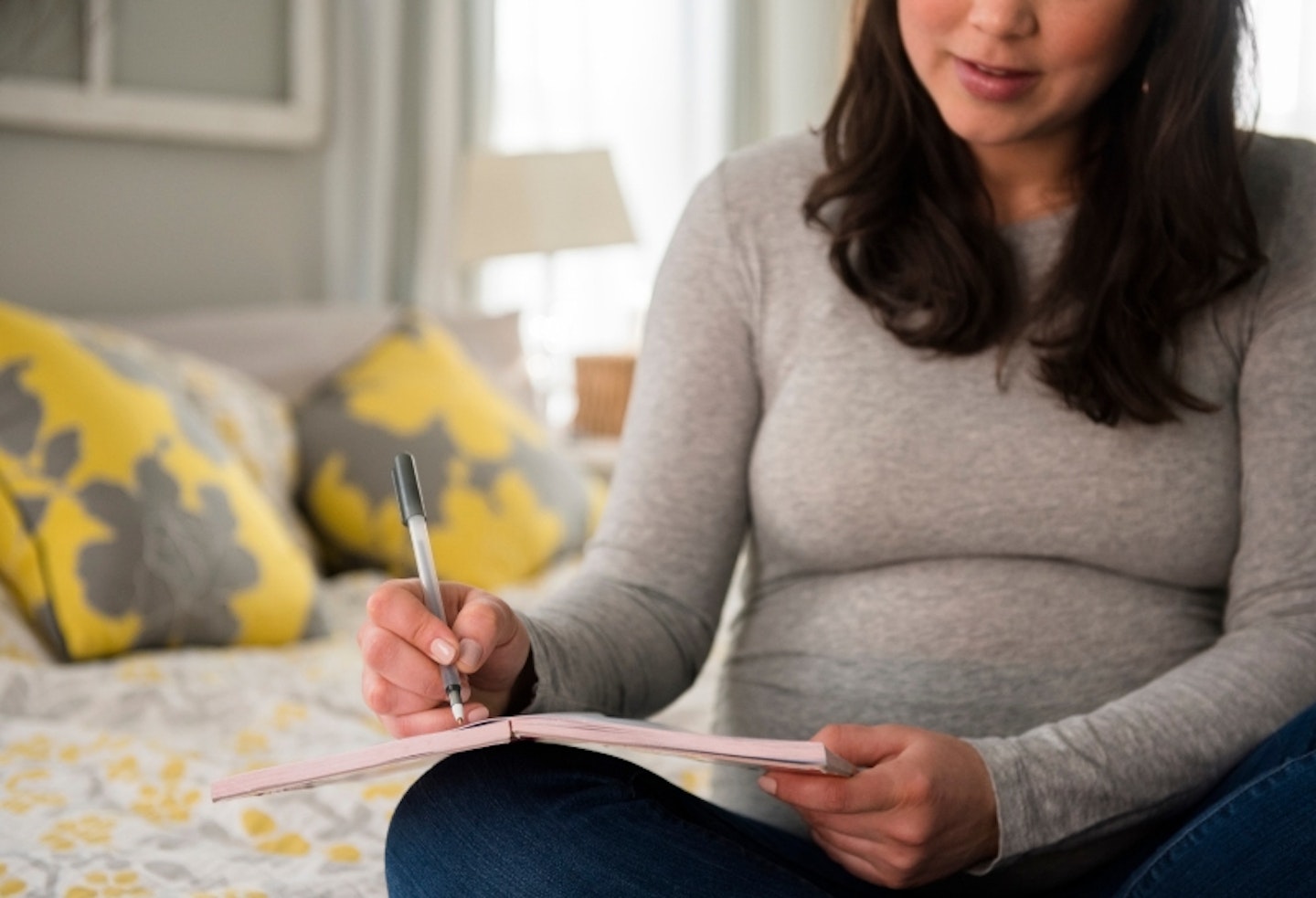If getting on top of things and feeling like you're organised helps you deal with pregnancy anxiety and stress, then a birth plan is a great idea. You can prepare for the labour while you’re still pregnant by writing a birth plan. This little bit of paperwork will help you to get your head around the process and will make sure you get the best experience for you.
Get inspiration from the experts
You can fill in an online birth plan on the NHS website. If you run your life via your phone, there are plenty of birth plan apps which can store your birth plan as well as organising your medical records and pregnancy diary. You'll probably want to start thinking about this around the 25 week mark of pregnancy.
There's nobody we trust more in birth than midwives. After helping with hundreds of births, some in-the-know midwives gave us their expert ideas when it came to their own labour plans.
While there’s a long list of practical decisions to be made about what sort ofbirth experience you want to have, we don’t very often think about labour as a personal journey.
"And what unites positive birth experiences – no matter what kind of birth the mother has had – is that she feels like she has been in the driving seat, and so in control of what’s taken place," says Sheena Byrom OBE, a midwife consultant, leader of the Midwifery Unit Network and author of Catching Babies.
Think about writing three separate birth plans:
-
A birth plan for your birth partner
-
A birth plan for yourself
"Having different directives for the different people in the room could help make sure that your wishes are articulated and acted on to the greatest extent possible," says Sheena.
How to write a birth plan:
How to write a birth plan
 1 of 11
1 of 111) When should I write my birth plan?
‘You’ll want to start thinking about your birth plan at around 32 weeks,’ says Gail Johnson, from the Royal College of Midwives. ‘This gives you the chance to consider your options and ask plenty of questions about labour and birth in advance.’
 2 of 11
2 of 112) What’s your perfect birth setting?
Use visualisation to help you decide – this mental imagery trick will help link your feelings and experiences.
‘Imagine you’re in labour and see yourself looking good, feeling great and full of confidence,’ says hypnobirthing teacher Judith Flood. Then look around you and note what’s going on. Put this in your plan.
Milli Hill, author and founder of the Positive Birth Movement, says it's good to be flexible about your birth setting. "It’s good to think of it in terms of flowchart," she says. "Say you're planning a home birth, if you transfer to a hospital, then this is what I want to happen when I'm in hospital. This is what I want if I then end up having a cesarean and this is what I don't want to happen. So, even if you don't want to have a cesarean, you make a cesarean plan.”
 3 of 11
3 of 113) Pain relief
Whether you want to give birth as naturally as possible, or you think you’d prefer every kind of pain relief available, it pays to stay open-minded.
In your birth plan, rate your preferences in order. For example, say you’ll start with gas and air, followed by pethidine, then an epidural if things get more painful than you’d like.
 4 of 11
4 of 114) Visit the delivery suite
Pain relief options depend on where you give birth. ‘There’s no point asking for a birthing pool if your chosen hospital doesn’t have one,’ says Gail.
Similarly, if you’ve elected to give birth at a midwife-led unit, an epidural won’t be an option, because it needs to be administered by a hospital anaesthetist. Chat with your midwife about your options, as they’ll know what’s on offer.
Milli says you should start with where you'd like to give birth when making your plan: "Where you want to give birth is a really interesting place to start. A lot of people don't realize they have a choice about that. You can give birth wherever you want, and there's no law to stop you from giving birth anywhere. So there's no ‘allowed’ or ‘not allowed’. So I think that's another good place to start.”
 5 of 11
5 of 115) Think about a C-section
25% of babies are born by C-section, so while it might not be top of your wish list, it’s wise to get clued up on what it involves. If you plan to have one, you need to know what to ask to get the caesarean that is right for you.
Think about whether you’d like a spinal block or a general anaesthetic. Do you want a running dialogue from the doctors who are delivering your baby, or would you prefer to just talk to your partner?
Milli says it's good to think about what you'd like to happen if you end up needing a cesarean: “The process of making a plan is helpful in terms of learning about your choices. And that that's a really important thing to do when you're having a baby because no matter what happens, you still have choices.”
Decisions that are good to make in advance are things like: ‘If I need a forceps delivery, I don't want to have that and I want to go straight to a cesarean.’”.
 6 of 11
6 of 116) Hospital bag
When it comes to packing your maternity bag, preparation is everything. After all, you don't want to be caught without a bag in case your baby decides to show up early! In your birth plan, you could include a checklist to help you prepare your hospital bag and to ensure you don't forget any essentials.
 7 of 11
7 of 117) Birthing music
If you feel soothed by music, listening to your favourite album may help you relax during a C-section. Many operating theatres have CD players or iPod docks, so check if you can play a soundtrack you’ve put together or check out these birthing playlist suggestions. A lot of obstetricians will be happy to oblige if it will make you feel more at ease.
This can be a great way to bring a bit of home with you into the hospital, especially if you had originally planned to give birth at home. However, Milli says that even if you've been told to go into hospital to have your baby, you can still stay at home if you want to. "If you if you have been told you can't have a home birth, and you actually have a little hankering for that kind of birth, then it's worth pushing a bit further," she says. You could say: ‘well, why, what's the evidence on which you're basing that advice? And, ‘what if we compromised?’, ‘What if I didn't have the home birth but came to the birth center?’.”
 8 of 11
8 of 118) Discuss with your birth partner
Don’t underestimate the dad-to-be’s role. Research from the University of Toronto recently showed that a supportive birth partner reduces the need for medical intervention and pain relief. And, if your partner understands what you want, they can speak up for you during labour, as well as encouraging and reassuring you.
So, make sure your partner is clear on what he needs to do come delivery day by writing your plan with him. ‘You may find you’d both benefit from some extra support, say, with your mum at the birth, too,’ says Gail.
 9 of 11
9 of 119) Write a mini plan for your birth partner
You might want to write a mini plan for your partner, reminding them what to bring to the hospital in their own labour bag. Think high-energy snacks, drinks, a book and a fully-charged camera with a new memory card.
This is also a great way to remind them what's important to you throughout the process. Milli says that, in this way, making the plan is almost as important as the finished document. "“People are telling people not to do it, but the point is that 75% of the value of the birth plan comes from making the plan, the process of making the plan, and educating yourself on your choices. The actual plan itself isn't the whole point.”
 10 of 11
10 of 1110) Final stages of labour
‘Most hospitals give you an injection to speed up the third stage, when your placenta is delivered,’ says doula Adela Stockton from Mindful Doulas. ‘If you’d prefer to deliver it naturally, make it clear in your birth plan.’
Sometimes in the final stages, things don't always go to plan. Milli says you can still have elements of your original plan invloved, even if what you think of as 'the worst' happens. “It should never be the case that you feel ‘I wanted all that but in the end everything went wrong and I couldn't have any of it’ . There could still be some things that you can carry through from your absolute Plan A all the way through to your ‘everything went tits up disaster plan’.”
 11 of 11
11 of 1111) After you’ve given birth
A birth plan is not just for labour – it’s also a good way to outline how you’d like to spend those precious few minutes after your baby has been born. Do you want to see the sex for yourself or be told? Does your partner want to cut the cord? Do you want your baby to be cleaned up or placed straight on you for skin-to-skin? What do you want to be done with the placenta - are you planning to eat it? Write it all down.
Milli says there are things that should always happen to give you a more positive experience. “There are things that should happen regardless of what goes on. Optimal cord clamping for example should happen in almost every situation, skin to skin contact with your baby. If you want to keep your placenta, for example, you know, things like that, that you should still be able to have no matter what goes what goes on.”
Birth plan chat with midwives Pip and Naghmeh
{#h-}
